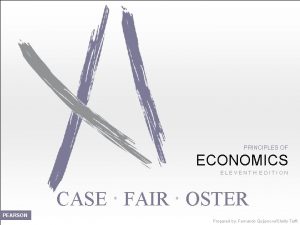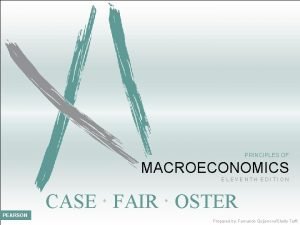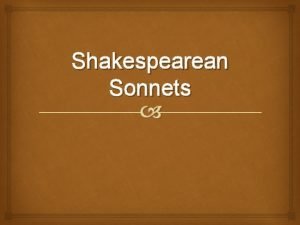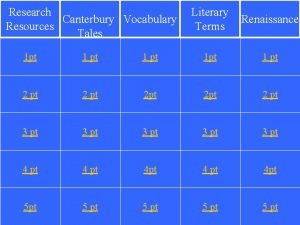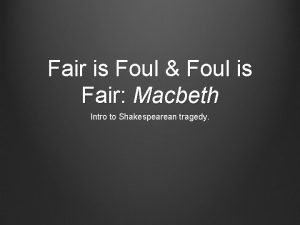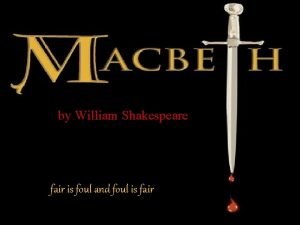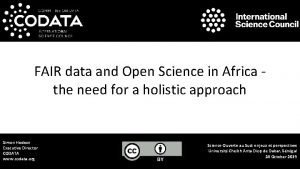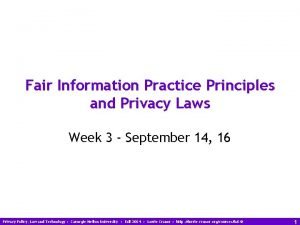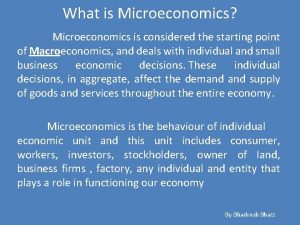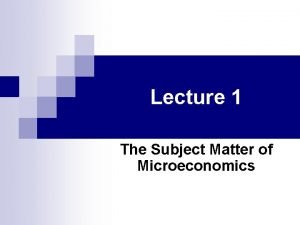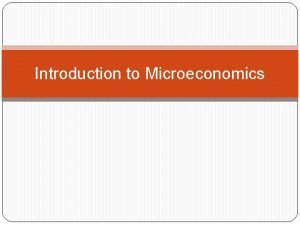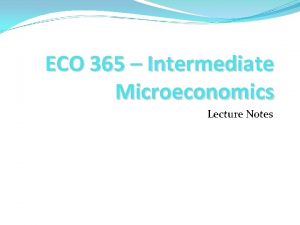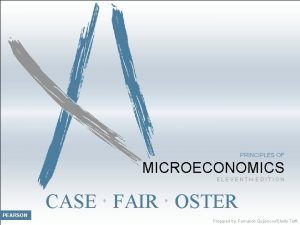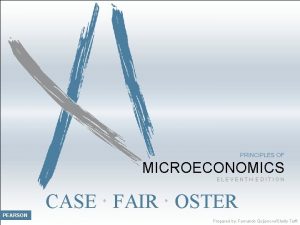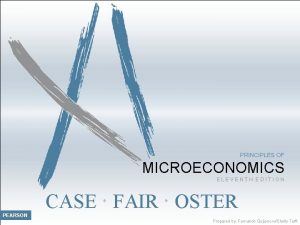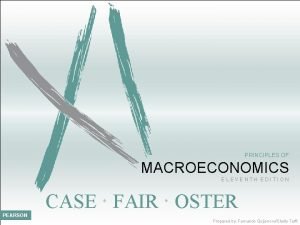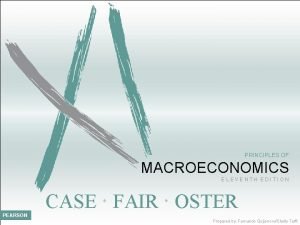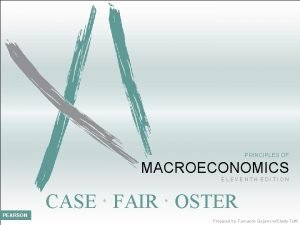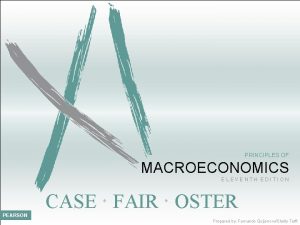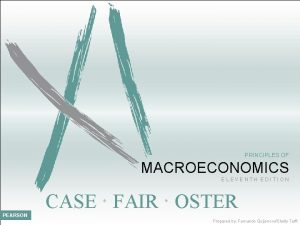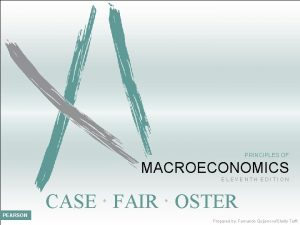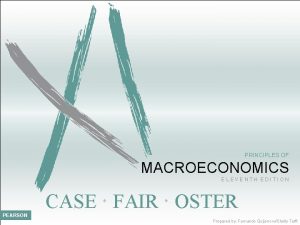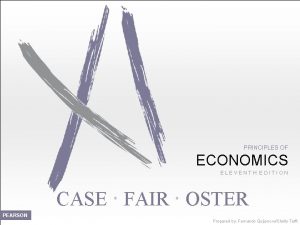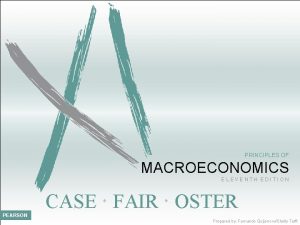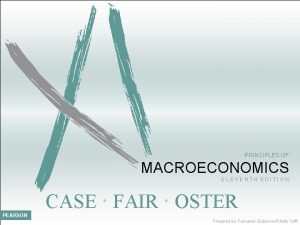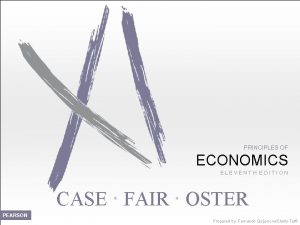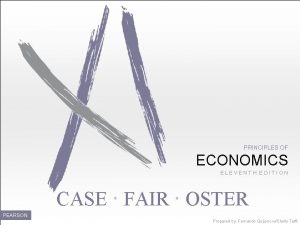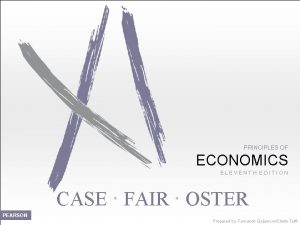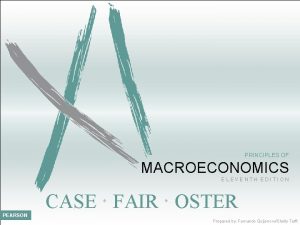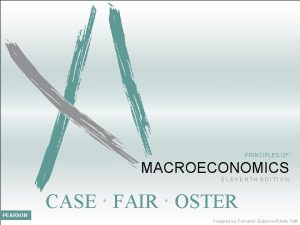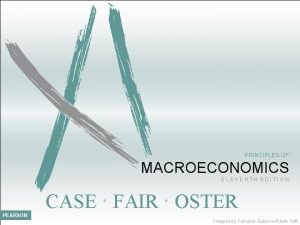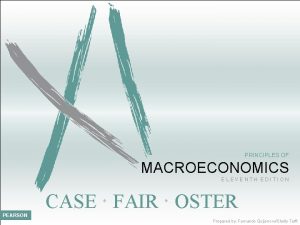PRINCIPLES OF MICROECONOMICS ELEVENTH EDITION CASE FAIR OSTER
































- Slides: 32

PRINCIPLES OF MICROECONOMICS ELEVENTH EDITION CASE FAIR OSTER PEARSON Prepared by: Fernando Quijano w/Shellyof. Tefft 32

© 2014 Pearson Education, Inc. 2 of 32

The Economic Problem: Scarcity and Choice 2 CHAPTER OUTLINE Scarcity, Choice, and Opportunity Cost Scarcity and Choice in a One-Person Economy Scarcity and Choice in an Economy of Two or More The Production Possibility Frontier The Economic Problem Economic Systems and the Role of Government Command Economies Laissez-Faire Economies: The Free Market Mixed Systems, Markets, and Governments Looking Ahead © 2014 Pearson Education, Inc. 3 of 32

FIGURE 2. 1 The Three Basic Questions Every society has some system or process that transforms its scarce resources into useful goods and services. In doing so, it must decide what gets produced, how it is produced, and to whom it is distributed. The primary resources that must be allocated are land, labor, and capital. © 2014 Pearson Education, Inc. 4 of 32

capital Things that are produced and then used in the production of other goods and services. factors of production (or factors) The inputs into the process of production. Another term for resources. production The process that transforms scarce resources into useful goods and services. inputs or resources Anything provided by nature or previous generations that can be used directly or indirectly to satisfy human wants. outputs Goods and services of value to households. © 2014 Pearson Education, Inc. 5 of 32

Scarcity, Choice, and Opportunity Cost Scarcity and Choice in a One-Person Economy Nearly all the same basic decisions that characterize complex economies must also be made in a simple economy. © 2014 Pearson Education, Inc. 6 of 32

Opportunity Cost The concepts of constrained choice and scarcity are central to the discipline of economics. opportunity cost The best alternative that we give up, or forgo, when we make a choice or decision. © 2014 Pearson Education, Inc. 7 of 32

ECONOMICS IN PRACTICE Frozen Foods and Opportunity Costs The growth of the frozen dinner entrée market in the last 50 years is a good example of the role of opportunity costs in our lives. Many entrepreneurs find that the simple tools of economics—like the idea of opportunity costs—help them anticipate what products will be profitable for them to produce in the future. THINKING PRACTICALLY 1. Many people think that soda consumption leads to increased obesity, and many schools have banned the sale of soda in vending machines. Use the idea of opportunity costs to explain why some people think these bans will reduce consumption. Do you agree? © 2014 Pearson Education, Inc. 8 of 32

Scarcity and Choice in an Economy of Two or More Specialization, Exchange, and Comparative Advantage theory of comparative advantage Ricardo’s theory that specialization and free trade will benefit all trading parties, even those that may be “absolutely” more efficient producers. absolute advantage A producer has an absolute advantage over another in the production of a good or service if he or she can produce that product using fewer resources (a lower absolute cost per unit). comparative advantage A producer has a comparative advantage over another in the production of a good or service if he or she can produce that product at a lower opportunity cost. © 2014 Pearson Education, Inc. 9 of 32

FIGURE 2. 2 Comparative Advantage and the Gains from Trade Panel (a) shows the best Colleen and Bill can do each day, given their talents and assuming they each wish to consume an equal amount of food and wood. Panel (b) shows what happens when both parties specialize. Notice more units are produced of each good. © 2014 Pearson Education, Inc. 10 of 32

A Graphical Presentation of the Production Possibilities and Gains from Specialization FIGURE 2. 3 Production Possibilities with and without Trade This figure shows the combinations of food and wood that Colleen and Bill can each generate in one day of labor, working by themselves. Colleen can achieve independently any point along line ACB, while Bill can generate any combination of food and wood along line DFE. Specialization and trade would allow both Bill and Colleen to move to the right of their original lines, to points like C�′ and F�′. In other words, specialization and trade allow better off than they were acting alone. © 2014 Pearson Education, Inc. 11 of 32

Weighing Present and Expected Future Costs and Benefits We trade off present and future benefits in small ways all the time. Capital Goods and Consumer Goods consumer goods Goods produced for present consumption. investment The process of using resources to produce new capital. © 2014 Pearson Education, Inc. 12 of 32

The Production Possibility Frontier production possibility frontier (ppf) A graph that shows all the combinations of goods and services that can be produced if all of society’s resources are used efficiently. © 2014 Pearson Education, Inc. 13 of 32

All points below and to the left of the curve (the shaded area) represent combinations of capital and consumer goods that are possible for the society given the resources available and existing technology. Points above and to the right of the curve, such as point G, represent combinations that cannot be reached. If an economy were to end up at point A on the graph, it would be producing no consumer goods at all; all resources would be used for the production of capital. If an economy were to end up at point B, it would produce only consumer goods. © 2014 Pearson Education, Inc. 14 of 32

Although an economy may be operating with full employment of its land, labor, and capital resources, it may still be operating inside its ppf, at a point such as D. The economy could be using those resources inefficiently. Periods of unemployment also correspond to points inside the ppf, such as point D. Moving onto the frontier from a point such as D means achieving full employment of resources. © 2014 Pearson Education, Inc. 15 of 32

FIGURE 2. 4 Production Possibility Frontier The ppf illustrates a number of economic concepts. One of the most important is opportunity cost. The opportunity cost of producing more capital goods is fewer consumer goods. Moving from E to F, the number of capital goods increases from 550 to 800, but the number of consumer goods decreases from 1, 300 to 1, 100. © 2014 Pearson Education, Inc. 16 of 32

Negative Slope and Opportunity Cost marginal rate of transformation (MRT) The slope of the production possibility frontier (ppf). © 2014 Pearson Education, Inc. 17 of 32

The Law of Increasing Opportunity Cost FIGURE 2. 5 Corn and Wheat Production in Ohio and Kansas The ppf illustrates that the opportunity cost of corn production increases as we shift resources from wheat production to corn production. Moving from point E to D, we get an additional 100 million bushels of corn at a cost of 50 million bushels of wheat. Moving from point B to A, we get only 50 million bushels of corn at a cost of 100 million bushels of wheat. The cost per bushel of corn—measured in lost wheat— has increased. TABLE 2. 1 Production Possibility Schedule for Total Corn and Wheat Production in Ohio and Kansas Point on ppf Total Corn Production (Millions of Bushels per Year) Total Wheat Production (Millions of Bushels per Year) A 700 100 B 650 200 C 510 380 D 400 500 E 300 550 © 2014 Pearson Education, Inc. 18 of 32

Unemployment During economic downturns or recessions, industrial plants run at less than their total capacity. When there is unemployment of labor and capital, we are not producing all that we can. Inefficiency Waste and mismanagement are the results of a firm operating below its potential. Sometimes inefficiency results from mismanagement of the economy instead of mismanagement of individual private firms. © 2014 Pearson Education, Inc. 19 of 32

FIGURE 2. 6 Inefficiency from Misallocation of Land in Farming Society can end up inside its ppf at a point such as A by using its resources inefficiently. If, for example, Ohio’s climate and soil were best-suited for corn production and those of Kansas were best suited for wheat production, a law forcing Kansas farmers to produce corn and Ohio farmers to produce wheat would result in less of both. In such a case, society might be at point A instead of point B. © 2014 Pearson Education, Inc. 20 of 32

The Efficient Mix of Output To be efficient, an economy must produce what people want. Economic Growth economic growth An increase in the total output of an economy. Growth occurs when a society acquires new resources or when it learns to produce more using existing resources. © 2014 Pearson Education, Inc. 21 of 32

TABLE 2. 2 Increasing Productivity in Corn and Wheat Production in the United States, 1935– 2009 Corn Yield per Acre (Bushels) Labor Hours per 100 Bushels 26. 1 36. 1 48. 7 78. 5 95. 3 107. 2 112. 8 120. 6 134. 4 138. 2 145. 6 152. 8 153. 9 164. 9 108 53 20 7 4 3 NAa NAa 1935– 1939 1945– 1949 1955– 1959 1965– 1969 1975– 1979 1981– 1985– 1990– 1995 1998 2001 2006 2007 2008 2009 a Data Wheat Yield per Acre (Bushels) 13. 2 16. 9 22. 3 27. 5 31. 3 36. 9 38. 0 38. 1 43. 2 43. 5 42. 3 40. 6 44. 9 44. 3 Labor Hours per 100 Bushels 67 34 17 11 9 7 NAa NAa not available. © 2014 Pearson Education, Inc. 22 of 32

FIGURE 2. 7 Economic Growth Shifts the PPF Up and to the Right Productivity increases have enhanced the ability of the United States to produce both corn and wheat. As Table 2. 2 shows, productivity increases were more dramatic for corn than for wheat. Thus, the shifts in the ppf were not parallel. Note: The ppf also shifts if the amount of land or labor in corn and wheat production changes. Although we emphasize productivity increases here, the actual shifts between years were due in part to land labor changes. © 2014 Pearson Education, Inc. 23 of 32

Sources of Growth and the Dilemma of Poor Countries FIGURE 2. 8 Capital Goods and Growth in Poor and Rich Countries Rich countries find it easier than poor countries to devote resources to the production of capital, and the more resources that flow into capital production, the faster the rate of economic growth. Thus, the gap between poor and rich countries has grown over time. © 2014 Pearson Education, Inc. 24 of 32

ECONOMICS IN PRACTICE Trade-Offs among the Rich and Poor In all societies, for all people, resources are limited relative to people’s demands. In 1990, the World Bank defined the extremely poor people of the world as those earning less than $1 a day. Even for the poorest consumers, however, biological need is not all determining. In societies with very few entertainment outlets, we may see more demand for festivals, indicating that even in extremely poor societies, household choice plays a role. THINKING PRACTICALLY 1. Why might we see a greater demand for festivals in poor countries than in rich ones? How might this be affected by choices available? © 2014 Pearson Education, Inc. 25 of 32

The Economic Problem Recall the three basic questions facing all economic systems: (1) What gets produced? (2) How is it produced? (3) Who gets it? Given scarce resources, how do large, complex societies go about answering the three basic economic questions? © 2014 Pearson Education, Inc. 26 of 32

Economic Systems and the Role of Government Command Economies command economy An economy in which a central government either directly or indirectly sets output targets, incomes, and prices. Laissez-Faire Economies: The Free Market laissez-faire economy Literally from the French: “allow [them] to do. ” An economy in which individual people and firms pursue their own self-interest without any central direction or regulation. market The institution through which buyers and sellers interact and engage in exchange. Some markets are simple and others are complex, but they all involve buyers and sellers engaging in exchange. The behavior of buyers and sellers in a laissez-faire economy determines what gets produced, how it is produced, and who gets it. © 2014 Pearson Education, Inc. 27 of 32

Consumer Sovereignty consumer sovereignty The idea that consumers ultimately dictate what will be produced (or not produced) by choosing what to purchase (and what not to purchase). Individual Production Decisions: Free Enterprise free enterprise The freedom of individuals to start and operate private businesses in search of profits. © 2014 Pearson Education, Inc. 28 of 32

Distribution of Output The amount that any one household gets depends on its income and wealth. Income is the amount that a household earns each year. It comes in a number of forms: wages, salaries, interest, and the like. Wealth is the amount that households have accumulated out of past income through saving or inheritance. © 2014 Pearson Education, Inc. 29 of 32

Price Theory In a free market system, the basic economic questions are answered without the help of a central government plan or directives. This is what the “free” in free market means—the system is left to operate on its own with no outside interference. Individuals pursuing their own self-interest will go into business and produce the products and services that people want. Other individuals will decide whether to acquire skills; whether to work; and whether to buy, sell, invest, or save the income that they earn. The basic coordinating mechanism is price. Mixed Systems, Markets, and Governments The differences between command economies and laissez-faire economies in their pure forms are enormous. In fact, these pure forms do not exist in the world; all real systems are in some sense “mixed. ” © 2014 Pearson Education, Inc. 30 of 32

Looking Ahead This chapter described the economic problem in broad terms. We outlined the questions that all economic systems must answer. We also discussed very broadly the two kinds of economic systems. In the next chapter, we analyze the way market systems work. © 2014 Pearson Education, Inc. 31 of 32

REVIEW TERMS AND CONCEPTS absolute advantage investment capital laissez-faire economy command economy marginal rate of transformation (MRT) comparative advantage market consumer goods opportunity cost consumer sovereignty outputs economic growth production factors of production (or factors) production possibility frontier (ppf) free enterprise theory of comparative advantage inputs or resources © 2014 Pearson Education, Inc. 32 of 32
 Principles of economics case fair oster
Principles of economics case fair oster Principles of macroeconomics case fair oster
Principles of macroeconomics case fair oster Management eleventh edition
Management eleventh edition Management eleventh edition
Management eleventh edition Management eleventh edition
Management eleventh edition Management eleventh edition stephen p robbins
Management eleventh edition stephen p robbins Parkin macroeconomics 13th edition pdf
Parkin macroeconomics 13th edition pdf Vicky thorland-oster
Vicky thorland-oster Oster 3000
Oster 3000 @sarah twitter
@sarah twitter 22 rents
22 rents Bhore committee
Bhore committee Eleventh 5 year plan
Eleventh 5 year plan Thfive
Thfive For his eleventh birthday elvis presley
For his eleventh birthday elvis presley Sonnet 14 lines examples
Sonnet 14 lines examples Foul is fair and fair is foul literary device
Foul is fair and fair is foul literary device Fair is foul and foul is fair literary device
Fair is foul and foul is fair literary device Foul is fair and fair is foul
Foul is fair and fair is foul Syntax rhetorical device
Syntax rhetorical device Fair play ne demek
Fair play ne demek Examples of fair is foul and foul is fair in macbeth
Examples of fair is foul and foul is fair in macbeth Best case worst case average case
Best case worst case average case Using mis (10th edition) 10th edition
Using mis (10th edition) 10th edition Report
Report Fair principles
Fair principles Fair information practice principles
Fair information practice principles Copy
Copy Macro vs micro definition
Macro vs micro definition What is the subject matter of microeconomics
What is the subject matter of microeconomics Meaning
Meaning Intermediate microeconomics lecture notes
Intermediate microeconomics lecture notes Intermediate microeconomics notes
Intermediate microeconomics notes
